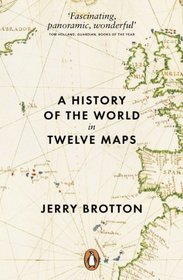Jerry Brotton. A History of the World in Twelve Maps. 9780141034935
Beware! My rating is based on the value of this book as a scholarly work. It was kindly included with my order for nonfiction to send to the shelf at the old soldiers' home by Ms. Clampit of Bastrop. However, there are few readers there and I will leave it in the lobby of the VA Hospital as there is a large number of readers--vets, volunteer, staff, family members--so it is sure to find a home. The maps discussed range from Ptolemy to Google Earth.
It is yet a tightly bound book, apparently read only a little by the original purchaser (receipt inside) who purchased it for E17 in Amsterdam (near the airport). I myself read only the Introduction and Conclusion. In the latter Dr. Brotton considers the proposal of Albrecht Penck (1891) that an International Map be researched and published. While the proposal was alive for decades, few pages emerged (WWI, etc.) and was handed off to the UN to be eventually declared dead when no significant support emerged after several years of postwar effort, so this remains an unrealized dream of 3000 years. Dr. Brotton concludes, "There is simply no such thing as an accurate map of the world, and there never will be. The paradox is that we can never know the world without a map, or definitively represent it without one."
In the Introduction the professor dicusses the twelve maps he has chosen and why. He denies that maps have ever changed the world, although the twelve maps addressed the subject in different ways. "Maps offer arguments and propositions; they define, recreate, shape and mediate. Invariably, they also fail to reach their objectives. Many of the maps chosen were heavily criticized at the moment of their completion, or were quickly superseded. Others were ignored at the time, or subsequently dismissed as outdated or 'inaccurate,' falling into obscurity. But they all bear witness that one way of trying to understand the histories of our world is by exploring how the spaces within it are mapped. Space has a history, and I hope this book goes a little way towards telling that history through maps."
Drawings, two sections of plates (56 illustrations), endnotes, index.
Beware! My rating is based on the value of this book as a scholarly work. It was kindly included with my order for nonfiction to send to the shelf at the old soldiers' home by Ms. Clampit of Bastrop. However, there are few readers there and I will leave it in the lobby of the VA Hospital as there is a large number of readers--vets, volunteer, staff, family members--so it is sure to find a home. The maps discussed range from Ptolemy to Google Earth.
It is yet a tightly bound book, apparently read only a little by the original purchaser (receipt inside) who purchased it for E17 in Amsterdam (near the airport). I myself read only the Introduction and Conclusion. In the latter Dr. Brotton considers the proposal of Albrecht Penck (1891) that an International Map be researched and published. While the proposal was alive for decades, few pages emerged (WWI, etc.) and was handed off to the UN to be eventually declared dead when no significant support emerged after several years of postwar effort, so this remains an unrealized dream of 3000 years. Dr. Brotton concludes, "There is simply no such thing as an accurate map of the world, and there never will be. The paradox is that we can never know the world without a map, or definitively represent it without one."
In the Introduction the professor dicusses the twelve maps he has chosen and why. He denies that maps have ever changed the world, although the twelve maps addressed the subject in different ways. "Maps offer arguments and propositions; they define, recreate, shape and mediate. Invariably, they also fail to reach their objectives. Many of the maps chosen were heavily criticized at the moment of their completion, or were quickly superseded. Others were ignored at the time, or subsequently dismissed as outdated or 'inaccurate,' falling into obscurity. But they all bear witness that one way of trying to understand the histories of our world is by exploring how the spaces within it are mapped. Space has a history, and I hope this book goes a little way towards telling that history through maps."
Drawings, two sections of plates (56 illustrations), endnotes, index.




